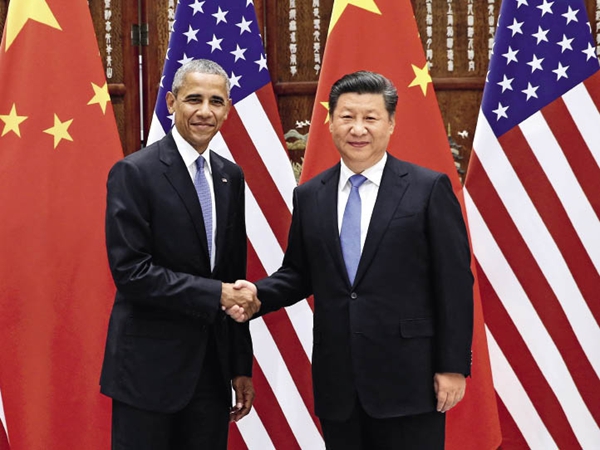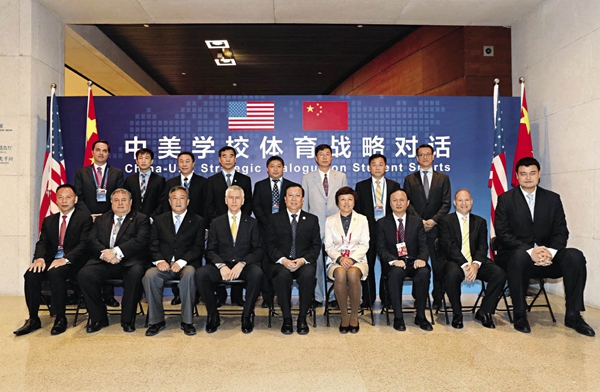People-to-People Exchange Galvanizes Sino-U.S. Relations
By CHENG HONGLIANG
THE quality of relationships between countries is based on affectionate ties between their peoples. The many facets of foreign relations, whether they be political, economic, diplomatic, military or cultural, involve everyone, from government officials and influential people, right down to ordinary citizens. As the ultimate purpose of a nation’s foreign relations is to best serve the interests of its people, it all boils down to creating bonds between peoples of different countries.

Chinese President Xi Jinping met with U.S. President Barack Obama, who was in China to attend the G20 summit, in Hangzhou, capital city of east China’s Zhejiang Province, on September 3, 2016.
For this reason, the closer the involvement of two peoples, the better the chance for their governments to make mutually beneficial policies. Divergence and dispute are sadly inevitable in international relations, but harmony between their respective peoples can ensure that the relationship between the two countries never strays from the road to stability and development.
Dialogue Between Peoples a Key Mechanism
The extent to which civilian exchanges have advanced international relations has surpassed expectations the world over. Their effect extends as far as reshaping the world situation and altering the course of human history. Back in 1971, the U.S. table-tennis team’s visit to China and the contact the players had with local athletes and citizens, opened a door leading to the restoration of full diplomatic relations between the two countries eight years later. This monumental event is aptly remembered in China as “the small ball which set the globe rolling.” Soon after establishing formal diplomatic relations on January 1, 1979, China and the U.S. dispatched their first groups of government-funded exchange students, which led to further civilian exchanges.
Sino-U.S relations have changed a lot since the 1970s. Now the consensus by their leaders is that China and America have one of the most important bilateral relationships in the world, which has a huge impact on world peace and stability. China and the U.S. each play the role of being the other’s biggest trading partner and maintain a level of interdependence never before seen in the history of bilateralism. Bilateral trade between the two countries has rocketed from below US $2.5 billion in 1979 to an astonishing US $560 billion today.
As the gap narrows between the strength and influence of the two countries, especially in this second decade of the 21st century, incidences of run-ins and conflicts of interest have increased. The development of bilateral ties between China and the U.S. is growing in complexity and the direction this development is taking concerns not just these two countries but the rest of the world as well.
After long negotiations, this prompted China and the U.S to set up a Strategic and Economic Dialogue in 2009 to help maintain healthy relations and common long-term interests. As a dialogue on strategic and long-term issues in the bilateral relationship and factors affecting its overall development, the Strategic and Economic Dialogue serves to clarify the stance of each country on particular issues, coordinate their respective policies, and facilitate communication over key issues of concern.
It takes more than government efforts, however, to develop thriving bilateral relationships. Citizens of the two countries should also be encouraged to contribute to the cause. When they met in April 2009, the Chinese State Councilor, Liu Yandong, and the U.S. Secretary of State, Hillary Clinton, agreed that the two governments would further encourage communication between their citizens and the consensus was to introduce a high-level intergovernmental consultation mechanism for people-to-people exchanges. This mechanism was later mentioned again in a joint statement between the two countries released during President Obama’s state visit to China in November the same year.
On May 25, 2010, the China-U.S. High-Level Consultation on People-to-People Exchange (CPE) convened its first meeting in Beijing, and has since become the most useful annual dialogue between the two countries along with the U.S.-China Strategic and Economic Dialogue (S&ED). So far seven sessions have been successfully concluded and the consultation has grown from strength to strength, despite leadership changes in China and the approaching end of the Obama administration. The CPE is the Sino-U.S. bilateral mechanism which has yielded the most fruitful results, featuring a broad spectrum of agreement and a narrow range of objection. Opinion amongst the top leaders of the two countries is favorable, and both governments list cultural and people-to-people exchange as a key component of their foreign policies.
Remarkable Achievements
The seven sessions of the CPE have produced remarkable results. The scope for people-to-people exchange is steadily increasing and new records are constantly being set for consultation results. During the first session, the two countries signed a Memorandum of Understanding, agreeing to take turns hosting the CPE. They also announced the “100,000 Strong” initiative – a program designed to increase the number of American students studying in China – as well as a Chinese program to send 10,000 doctoral candidates to the U.S. Additional activities were planned, including cultural forums and a celebration of the 40th anniversary of the development of diplomatic relations kickstarted by the American ping-pong team in 1971.
After the second meeting the results multiplied to include more than 40 items in six different fields – education, science & technology, culture, women, youth and sports. By the fifth session the number of results were upwards of 100. A seventh field – health care – was added at the sixth meeting in 2015. A new record of 158 results was set this year at the seventh session, the last during President Obama’s time in office.
The CPE participants include both governmental and non-governmental persons. In the early days of the consultation the two sides struck intergovernmental deals on cooperation projects to facilitate exchange between their respective citizens. Later the government stepped back into a bridging role, giving more space to the involvement of the private sector. Universities, businesses, social organizations and even individuals have since begun to take center stage. With their ardent participation, the CPE remains true to its purpose of facilitating people-to-people exchange.

China-U.S. Strategic Dialogue on Student Sports opens at the National Museum of China, Beijing, on June 7, 2016.
This cultural exchange is deepening and becoming more diversified. NBA stars visited Chinese primary and middle schools, and Chinese culture and art have found their way to bigger U.S. audiences. The two countries have recognized global challenges like climate change and acknowledged the significance of cultivating cooperative awareness amongst their citizens at an early age, prompting them to design a series of activities to foster a cooperative spirit in future generations.
China’s people-to-people exchange initiatives are developing from bilateral ones into trilateral and even global exchanges. In the past seven years, exchanges within the CPE framework have become more extensive, intensive and substantive, with more active and rewarding participation from citizens.
As part of the continued enhancement of bilateral relations between these two great powers, China and the United States should give serious thought to how their cultural exchanges can contribute to global progress. After the 2014 Ebola outbreak in West Africa, Chinese and American medical workers collaborated to implement a swift response to the crisis, adding a new global dimension to Sino-U.S people-to-people exchange. The two countries have made a joint effort to cultivate medical professionals and conduct more cooperative programs combating serious diseases.
Stabilizing Relations
People-to-people exchange helps to stabilize the relationship between China and the U.S. A recent U-turn of American foreign policy – including political, economic and military issues – has increased pressure on China and made bilateral ties complicated and volatile to an unprecedented degree. Added to this, unhelpful involvement from other countries has made this difficult relationship the focus of international relations worldwide and has added fuel to the fire already surrounding the contest between the two powers in the Asia-Pacific region.
Despite there being disagreements on a variety of issues between Chinese and American officials, strategists and academics, the two countries continue to maintain a rare high level of agreement about the fruitful and positive nature of cultural and people-to-people exchanges and their supportive role in strengthening bilateral ties. Some think tanks in the U.S. have labeled people-to-people exchange the most effective means of combating rivalry between the two countries.
Take education as an example: America’s “100,000 Strong” initiative and China’s plan to send 10,000 doctoral candidates to the U.S, both hit their targets ahead of schedule. Encouraged by these successful results, America rolled out the “One Million Strong” initiative, and China responded with an injection of government funding for more Chinese to study in the U.S. China is currently America’s largest source of foreign students and the U.S. the second largest source of foreign students in China. Every day more than 10,000 people travel between the two countries. Closer ties between their people and economies have prompted Chinese and American policymakers to deal with bilateral relationship more rationally and manage their disputes more proactively, so that their countries will remain on course to build a new type of major-country relationship.
Building Broader Diplomacy
Cultural and people-to-people exchanges are a critical new constituent of China-U.S. diplomacy. Based on the success of cultural exchanges with America, China has initiated similar consultation mechanisms with other countries, including the U.K, France and other EU countries, Russia and Indonesia. Mutual political trust; trade and economic cooperation; and cultural and people-to-people exchanges – found to be the three pillars of Sino-U.S. relations – are now the guidelines for China’s relationships with all other countries.
The U.S has, in turn, replicated the “100,000 Strong” initiative in Latin America, and has upgraded cultural & people-to-people exchanges around the world. It has also made trade and economic cooperation a cornerstone of its relationships with priority countries and regions. Successful people-to-people exchange between China and America is exerting a subtle influence on their diplomatic relations with each other and the rest of the world.
Cultural and people-to-people exchange has its own special rules and traits. The effect of this sort of diplomacy takes longer to make itself felt, unlike strategic or economic agreements which may yield more immediate results. It is possible for some cultural programs to see handsome social or economic returns, but in general people-to-people exchange is definitely not a quick fix. It is a long-term systematic undertaking which invests in future generations.
If the program aims high, however, and the exchange is carried out in an intensive, substantive and innovative manner, the public can be encouraged to participate and reap the benefits. In time, we will see a lasting, pronounced strengthening effect of people-to-people exchange on Sino-U.S. relations.
The U.S. will hold elections this November. The new president’s foreign policy towards China might differ from that of the Obama administration, but cultural and people-to-people exchange should not be neglected, for it serves as the cornerstone of stability and the catalyst for a progressive relationship between the two countries.
CHENG HONGLIANG is a deputy researcher in American studies with the China Institute of Contemporary International Relations.
